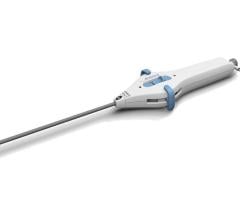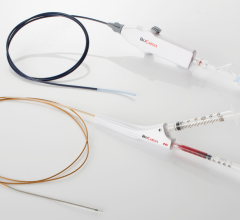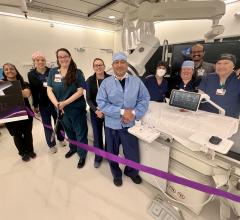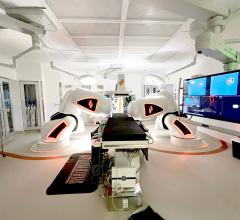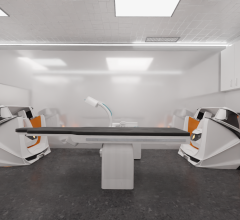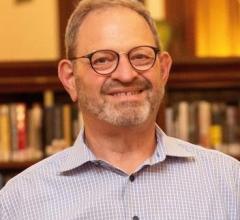
October 6, 2021 – Biosense Webster announced the first cases using a radiofrequency balloon ablation catheter were completed in September at sites across Europe using the Biosense Webster Heliostar Balloon Ablation Catheter. In Europe, the Heliostar Balloon Catheter is indicated for use in catheter-based cardiac electrophysiology (EP) mapping of the atria and for cardiac ablation.
The Heliostar Balloon Ablation Catheter, with the Lassostar Catheter and Carto 3 System, allows physicians to provide more efficient ablation procedures, with lower procedure times and reduced fluoroscopy time and exposure, potentially benefitting both the patient and physician.[1,2,3] In a multicenter single-arm study, SHINE (n=95), fluoroscopy time was 10.9 ± 9.1 minutes in per-protocol population while in a multicenter single-arm study RADIANCE (n=40), fluoroscopy time was 17.4 ± 10.1 minutes without using Lassostar Diagnostic Catheter.[4,5] This shorter procedure time may require less anesthesia and radiation and may result in less nursing and facility time. These time savings may also enable more procedures per day facilitating patient access.[6,7]
The novel Heliostar Balloon Ablation Catheter features 10 gold-plated, irrigated electrodes that can be tailored based on anatomical location and known tissue thickness enabling personalized ablation procedures for unique patient anatomies and arrhythmias.[8,9] The amount of power delivered to each electrode can be controlled independently to provide electrophysiologists with greater customization, control and the ability to achieve pulmonary vein (PV) isolation in approximately 10 seconds.
“Pulmonary vein isolation is a technically complex and time-consuming procedure so it’s important that advancements in balloon ablation systems help electrophysiologists quickly and easily isolate the pulmonary veins, while maintaining safety,” said Ahmed Abdelaal, senior R&D director and Heliostar project leader at Biosense Webster. “The Heliostar Balloon Ablation Catheter was developed with electrophysiologists in mind giving them the ability to perform personalized ablation procedures to better meet patient’s needs.”
In a multicenter single-arm study, SHINE, the Heliostar Balloon Ablation Catheter was an effective treatment for paroxysmal atrial fibrillation (AF) and electrophysiologists isolated targeted pulmonary veins (PV) in 98.8% of patients without the need for focal touch-up.[4] On average, time to isolation of the pulmonary vein was approximately 10 seconds, total procedure time was less than 90 minutes and dwell time was less than 40 minutes.[4]
"The Heliostar Balloon Ablation Catheter reaffirms our commitment to partnering with physicians to advance the practice of electrophysiology and to help change the lives of patients suffering from atrial fibrillation,” said Uri Yaron, worldwide president of Biosense Webster Inc. “With CE mark approval and the first commercial procedures completed, we have made significant progress in providing electrophysiologists with another novel option for the safe and efficient treatment of this burdensome disease.”
In Europe, full commercial availability is expected in 2022. In the United States, Heliostar is an investigational device and is not approved by the U.S. Food and Drug Administration.
Europe is home to more than 11 million people living with atrial fibrillation (AF), and estimates state that by 2030 the number of people with AF is projected to increase by up to 70%.[10,11] In Europe, catheter ablation is a recommended first-line treatment option [12] and is associated with a significant improvement in quality of life and significant reductions in AF burden and AF-related complications.[13,14,15]
For more information: www.biosensewebster.com
First Patient Treated in STELLAR Atrial Fibrillation IDE Study
What is New in Electrophysiology Technologies
References:
6. Klein G, Lickfett L, Schreieck J, Deneke T, Wieczorek M et al. (2015) Comparison of ‘anatomically designed’ and ‘point-by-point’ catheter ablations for human atrial fibrillation in terms of procedure timing and costs in German hospitals. Europace. 17 (7): 1030-1037.
6. Yildiz M, Yilmaz Ak H, Oksen D, Oral S. Anesthetic Management In Electrophysiology Laboratory: A Multidisciplinary Review. J Atr Fibrillation. 2018;10(5):1775. Published 2018 Feb 28. doi:10.4022/jafib.1775.
8. HELIOSTAR™ Balloon Ablation Catheter Clinical Evaluation Report 100503977 Rev 3; CO:100610371.
9. Grimaldi et al., Impact of Workflow Modifications in Atrial Fibrillation Ablation for Reducing the Incidence of Silent Cerebral Lesions with a New Multi-Electrode Radiofrequency Balloon Catheter, ESC 2019.
10. Global Burden of Disease Collaborative Network (2016) Global Burden of Disease Study 2016 (GBD 2016) Results. Seattle, United States: Institute for Health Metrics and Evaluation (IHME), 2017. Accessed 2018-04-20. Available from http://ghdx.healthdata.org/gbd-results-tool.
11. Zoni-Berisso M, Lercari F, Carazza T, Domenicucci S (2014) Epidemiology of atrial fibrillation: European perspective. Clin Epidemiol. 6: 213-220.
12. Hindricks G et al. 2020 ESC Guidelines for the diagnosis and management of atrial fibrillation developed in collaboration with the European Association for Cardio-Thoracic Surgery (EACTS): The Task Force for the diagnosis and management of atrial fibrillation of the European Society of Cardiology (ESC) Developed with the special contribution of the European Heart Rhythm Association (EHRA) of the ESC. Eur Heart J. 2021 Feb 1;42(5):373-498.
13. Walfridsson, Håkan, et al. "Radiofrequency ablation as initial therapy in paroxysmal atrial fibrillation: results on health-related quality of life and symptom burden. The MANTRA-PAF trial." EP Europace. 17.2 (2015): 215-221.
14. Blomström-Lundqvist, Carina, et al. "Effect of catheter ablation vs antiarrhythmic medication on quality of life in patients with atrial fibrillation: the CAPTAF randomized clinical trial." JAMA. 321.11 (2019): 1059-1068.
15. Journal of Nursing: June 2019 - Volume 119 - Issue 6 - p 18 doi:10.1097/01.NAJ.0000559795.09114.0b.


 April 29, 2025
April 29, 2025 


